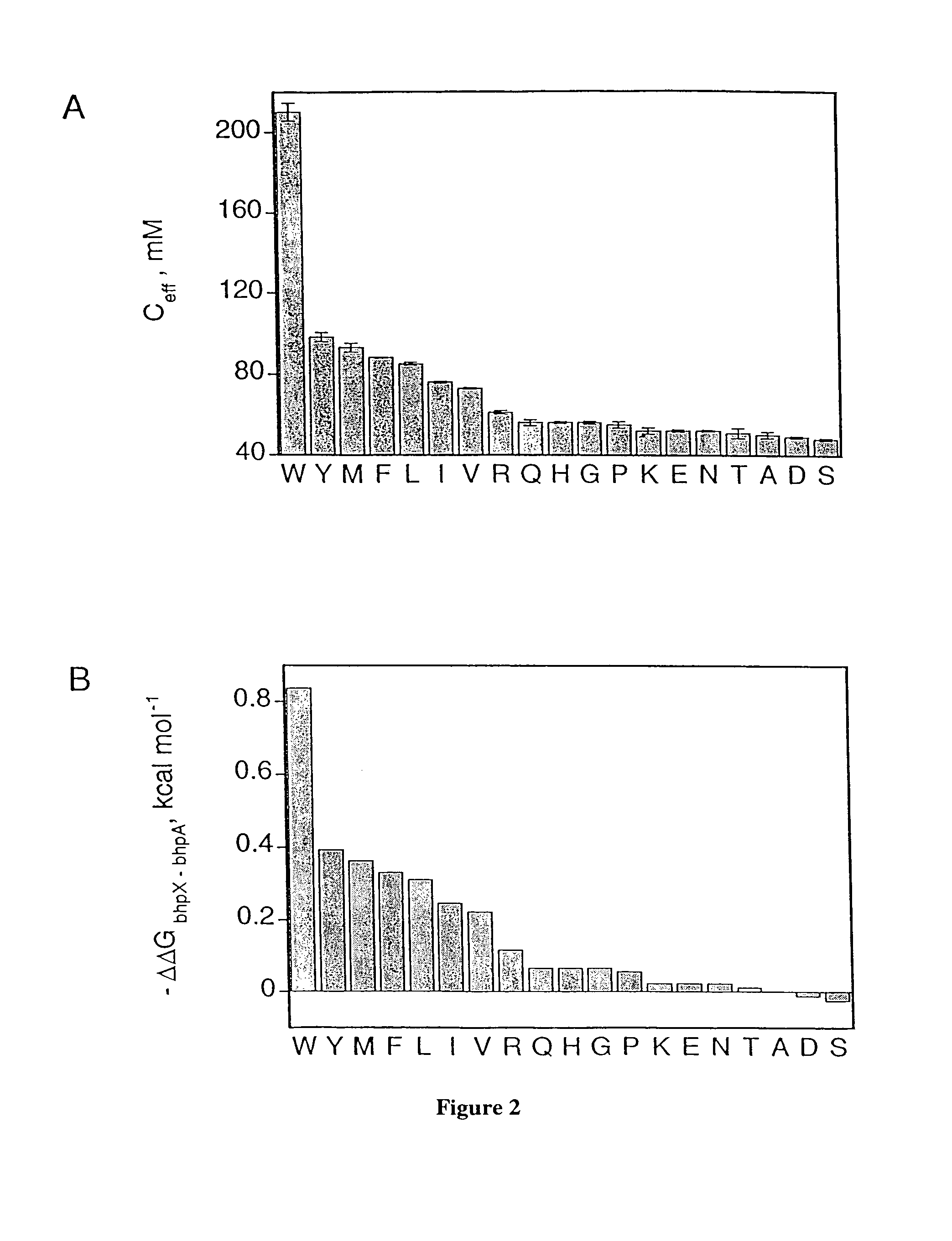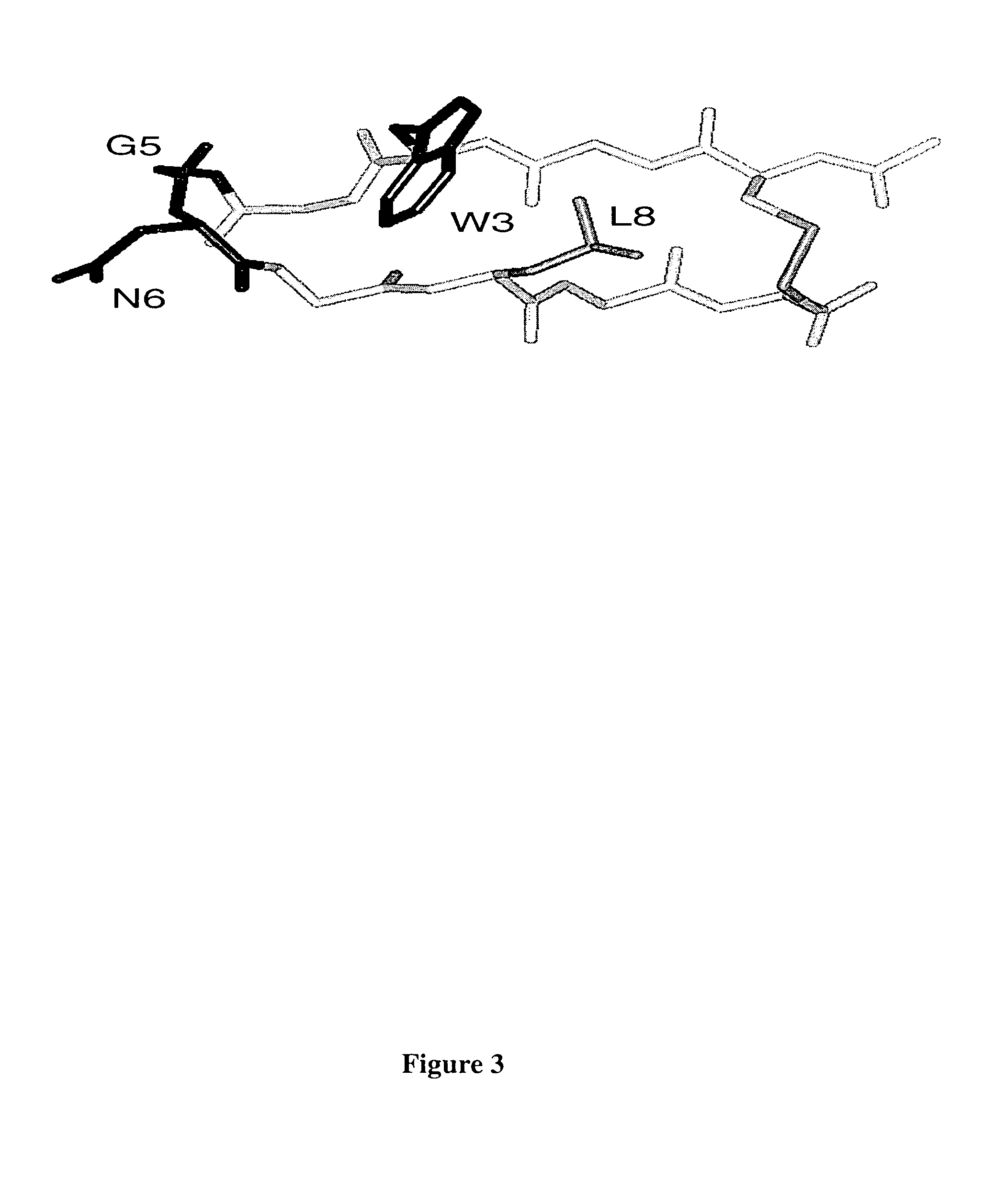Structured peptide scaffold for displaying turn libraries on phage
a phage and peptide technology, applied in the field of protein structureactivity relationship studies, can solve the problems of reducing the affinity of peptides, unable to maintain structure, and difficult to determine the active conformation of molecules,
- Summary
- Abstract
- Description
- Claims
- Application Information
AI Technical Summary
Benefits of technology
Problems solved by technology
Method used
Image
Examples
example 1
Design of a Structured, Disulfide-Constrained β-Hairpin Peptide Scaffold
[0131]In this example, we chose to investigate disulfide-constrained β-hairpins of the decamers in the form of CX8C as scaffolds for β-turn display. For our purpose, it is essential to design a structure compatible with many turn sequences. That is, residues other than those in the turn must significantly bias the peptide toward hairpin structure. Disulfide cyclization is helpful, although not sufficient to structure many peptides. Our initial objective was to determine whether the disulfide bond could be used not only as a covalent constraint, but also to nucleate a more extended interaction of the β-strands.
Materials and Methods
[0132]Peptide Synthesis. Peptides were synthesized using standard Fmoc chemistry on a Pioneer synthesizer (PE Biosystems), cleaved from resin with 5% triisopropylsilane in trifluoroacetic acid (TFA), and purified by reversed-phase HPLC (acetonitrile / H2O / 0.1% TFA). Peptide identity was c...
example 2
Transfer of Alternative Tetrapeptide Turn Sequences onto the Hairpin Scaffold
[0143]Structures calculated for bhpw according to Example I revealed a well formed antiparallel hairpin with a type II′ turn (Gly5-Asn6), and hydrophobic contacts between the side chains of Cys1, Trp3, Leu8 and Cys10 (FIG. 3). Thermodynamic analysis of bhpW stability was complicated by the failure of the oxidized peptide to unfold fully, either at high temperature or in the presence of chemical denaturants. Nevertheless, we estimate the hairpin conformation to be highly populated, most likely>80%, at 15° C. Because of its structural stability, we have chosen bhpw for investigation as a turn display scaffold. Accordingly we tested whether a different turn sequence could be structured by the bhpw strand sequences.
[0144]A recent crystal structure of HIV gp120 bound to a neutralizing antibody and to human CD4 revealed details of the contact surfaces (Kwong et al. (1998) Nature 393:648-659.). As had been anticip...
example 3
Quantification of the Relative Contributions from Turns and Cross-Strand Interactions
[0156]In Example 1 above, substitutions were introduced into position 3 (X) of the model peptide bhp (peptide 1). This guest site is quite close in space to the type II′ turn (gly-asn, FIG. 1). To further investigate whether hairpins with different turn sequences and geometries would have different residue preferences at the NHB guest site, the central gly-asn sequence in model peptide 1 is replaced with the type I′ turn asn-gly (peptide 2) and the type II′ turns D-pro-asn and D-pro-gly (peptides 3 and 4). Substitutions at position 3 (X) were chosen to span the range of hairpin stabilities we observed in the gly-asn series. Ceff was measured as previously described in Example 1. The values we obtain for the different turns are compared in FIG. 6.
[0157]
Ac-CT X E GN KLTC- NH21II′(SEQ ID NO:16)Ac-CT X E NG KLTC- NH22I′X = W, Y, L, V, T, D(SEQ ID NO:17)Ac-CT X E pN KLTC- NH23II′p ≡ D-pro(SEQ ID NO:18)Ac...
PUM
| Property | Measurement | Unit |
|---|---|---|
| concentration | aaaaa | aaaaa |
| concentration | aaaaa | aaaaa |
| concentration | aaaaa | aaaaa |
Abstract
Description
Claims
Application Information
 Login to View More
Login to View More - R&D
- Intellectual Property
- Life Sciences
- Materials
- Tech Scout
- Unparalleled Data Quality
- Higher Quality Content
- 60% Fewer Hallucinations
Browse by: Latest US Patents, China's latest patents, Technical Efficacy Thesaurus, Application Domain, Technology Topic, Popular Technical Reports.
© 2025 PatSnap. All rights reserved.Legal|Privacy policy|Modern Slavery Act Transparency Statement|Sitemap|About US| Contact US: help@patsnap.com



